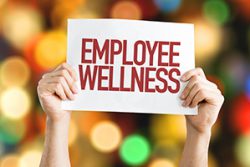How to Help Employees Attend to Their Health and Wellness During the Holidays
 While there are numerous signs of the semester winding down, there are likely as many (or more!) signs that the holiday season is in full swing. This time of year may be a time for celebration, but it can also be incredibly stressful — for everyone.
While there are numerous signs of the semester winding down, there are likely as many (or more!) signs that the holiday season is in full swing. This time of year may be a time for celebration, but it can also be incredibly stressful — for everyone.
A recent survey by Accountemps found that while 51 percent of workers reported being happier during the holiday season, 35 percent said they were more stressed this time of year, with the biggest source of stress being balancing work responsibilities with holiday events.
Many employers are recognizing this, and are ramping up employee well-being efforts. CUPA-HR’s 2017 Employee Healthcare Benefits in Higher Education Report showed that although wellness programs sharply decreased on campuses in 2016, they seem to be making a comeback. Many institutions are combining their wellbeing, work-life and employee assistance programs to offer emotional, physical, professional, social and spiritual support to campus community members. Implementing and keeping them going takes perseverance.
In the CUPA-HR webinar HR Be Nimble: Work-Life and Well-Being, presenters Janet Walker and Linda Harber from George Mason University acknowledge that creating a culture of well-being takes time. It is a long-term goal with long-term investments, which requires the patience to build “culture turners” who are engaged in collaborating on goals and keeping track of results.
Health, Wellness and Work-Life
- New Jersey City University’s Dealing With Holiday Stress website encourages staff, faculty and students to be realistic about expectations during the holidays, set limits, and use good decision-making strategies to reduce stress levels. Some suggestions: pace yourself; be practical about what you can and can’t do; take care of your body; and do something for others.
- Oklahoma State University-Tulsa’s academic program, student major’s club and Health and Human Performance Lab act as a clearing house for health information, strive to build leadership capacity in health promotion, and model healthy lifestyle choices for the Tulsa community. They provide a portal to wellness information, offer strategies for improving the health of communities, and empower communities to build and leverage their social capital for institutionalizing sustainable health practices.
- Maricopa Community Colleges envisions an environment that recognizes the value of everyone’s wellbeing. Wellness Maricopa works collaboratively with the benefits office to offer flu shots, wellness fairs and health screenings. They even celebrate wellness by showcasing photos on their website of campus community members engaging in their favorite health and wellbeing activities.
- Oregon State University’s Office of Work-Life promotes the ongoing development of a workplace culture that is supportive of personal and family life. OSU offers family-friendly policies and benefits, a family resource center, work-life consultations and more. Services are extended to employees’ spouses/partners and dependents.
There are numerous and exceptional health, wellness and work-life resources in practice at colleges and universities across the country. What types of health, wellness and employee assistance does your institution offer? How are you making sure your employees know about and use them?
Additional Resources:
Wellness Programs Toolkit in the Knowledge Center
Webinar: Employee Well-Being: How-Tos and Takeaways From Two Successful Programs
Webinar: Employee Well-Being: Collaborative Partnerships Between Campus Recreation, Wellness and HR
Addressing Distress Before It Becomes Disaster: How HR at One University Is Driving a Threat Prevention and Assessment Program for Staff and Faculty


